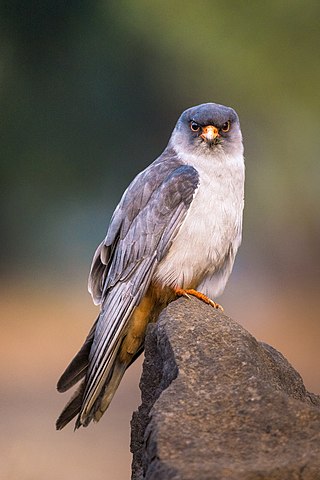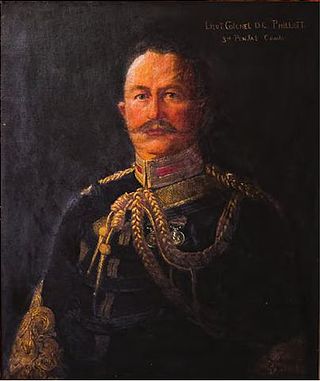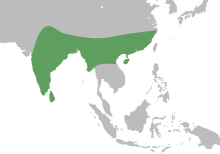
Falcons are birds of prey in the genus Falco, which includes about 40 species. Falcons are widely distributed on all continents of the world except Antarctica, though closely related raptors did occur there in the Eocene.

The peregrine falcon, also known simply as the peregrine, and historically as the duck hawk in North America, is a cosmopolitan bird of prey (raptor) in the family Falconidae. A large, crow-sized falcon, it has a blue-grey back, barred white underparts, and a black head. The peregrine is renowned for its speed. It can reach over 320 km/h (200 mph) during its characteristic hunting stoop, making it the fastest member of the animal kingdom. According to a National Geographic TV program, the highest measured speed of a peregrine falcon is 389 km/h (242 mph). As is typical for bird-eating (avivore) raptors, peregrine falcons are sexually dimorphic, with females being considerably larger than males.

Falconry is the hunting of wild animals in their natural state and habitat by means of a trained bird of prey. Small animals are hunted; squirrels and rabbits often fall prey to these birds. Two traditional terms are used to describe a person involved in falconry: a "falconer" flies a falcon; an "austringer" keeps Goshawks and uses accipiters for hunting. In modern falconry, the red-tailed hawk, Harris's hawk, and the peregrine falcon are some of the more commonly used birds of prey. The practice of hunting with a conditioned falconry bird is also called "hawking" or "gamehawking", although the words hawking and hawker have become used so much to refer to petty traveling traders, that the terms "falconer" and "falconry" now apply to most use of trained birds of prey to catch game. However, many contemporary practitioners still use these words in their original meaning.

The merlin is a small species of falcon from the Northern Hemisphere, with numerous subspecies throughout North America and Eurasia. A bird of prey once known colloquially as a pigeon hawk in North America, the merlin breeds in the northern Holarctic; some migrate to subtropical and northern tropical regions in winter. Males typically have wingspans of 53–58 centimetres (21–23 in), with females being slightly larger. They are swift fliers and skilled hunters which specialize in preying on small birds in the size range of sparrows to quail. The merlin has for centuries been well regarded as a falconry bird. In recent decades merlin populations in North America have been significantly increasing, with some merlins becoming so well adapted to city life that they forgo migration.

The shikra is a small bird of prey in the family Accipitridae found widely distributed in Asia and Africa where it is also called the little banded goshawk. The African forms may represent a separate species but have usually been considered as subspecies of the shikra. The shikra is very similar in appearance to other falcons species including the Chinese goshawk and Eurasian sparrowhawk. They have a sharp two note call and have the typical flap and glide flight. Their calls are imitated by drongos and the common hawk-cuckoo resembles it in plumage.

The red-necked falcon is a bird of prey in the falcon family with two disjunct populations, one in India and the other in Africa. This medium-sized falcon has bluish grey wings and upper body, a chestnut red cap with short chin straps passing through the eye. The primary feathers of the wing are black and a single black band at the tip of the tail are distinctive. The Indian subspecies Falco chicquera chicquera also known as the red-headed merlin or red-headed falcon is found mainly in the open plains of the India Subcontinent although it is thought to have occurred further west in southeastern Iran. The subspecies Falco chicquera ruficollis found in sub-Saharan Africa is sometimes treated as a full species, the rufous-necked falcon, on the basis of its well-separated geographic range and distinctive pattern. It appears very similar to the Indian form but has dark barring on the upperparts, a rufous breast band, and black moustachial and eye stripes. As in most falcons, the females are larger and falconers in India called the female turumti and the male as chatwa. They hunt in pairs mostly at dawn and dusk, capturing small birds, bats and squirrels.

The lanner falcon is a medium-sized bird of prey that breeds in Africa, southeast Europe and just into Asia. It prefers open habitat and is mainly resident, but some birds disperse more widely after the breeding season. A large falcon, it preys on birds and bats. Most likely either the lanner or peregrine falcon was the sacred species of falcon to the ancient Egyptians, and some ancient Egyptian deities, like Ra and Horus, were often represented as a man with the head of a lanner falcon.

The Barbary falcon is a medium-sized falcon about the size of a crow. This bird of prey is mainly resident. It ranges from the Canary Islands eastwards across some parts of North Africa, the Middle East and Central Asia.

The saker falcon is a large falcon species. It breeds from Central Europe eastwards across the Palearctic to Manchuria. It is a partial migrant, which means that some part of the population is migratory, some part is not. In Europe, for example, a part of the juveniles are migrating, while adults are mostly resident. The European and West Asian migratory sakers spend the winter in the Sahel region. On migration, they cross the Middle East, the Arabian peninsula, and Pakistan, where they are exposed to illegal trapping. The migratory birds to the east from Altai Mountains spend the winter in the Qinghai-Tibet Plateau.

The prairie falcon is a medium-large sized falcon of western North America. It is about the size of a peregrine falcon or a crow, with an average length of 40 cm (16 in), wingspan of approximately 1 meter (40 in), and average weight of 720 g (1.6 lb). As in all falcons, females are noticeably bigger than males. Though a separate species from the peregrine, the prairie falcon is basically an arid environment divergence of the early peregrine falcon lineage, able to subsist on less food than the peregrine, and generally lighter in weight than a peregrine of similar wing span. Having evolved in a harsh desert environment with low prey density, the prairie falcon has developed into an aggressive and opportunistic hunter of a wide range of both mammal and bird prey. It will regularly take prey from the size of sparrows to approximately its own weight, and occasionally much larger. It is the only larger falcon native only to North America. It is resident from southern Canada, through western United States, and into northern Mexico. The prairie falcon is popular as a falconry bird, where with proper training it is regarded as being as effective as the more well known peregrine falcon.

The aplomado falcon is a medium-sized falcon of the Americas. The species' largest continuous range is in South America, but not in the deep interior Amazon Basin. It was long known as Falco fusco-coerulescens or Falco fuscocaerulescens, but these names are now believed to refer to the bat falcon. Its resemblance in shape to the hobbies accounts for its old name orange-chested hobby. Aplomado is an unusual Spanish word for "lead-colored", referring to the blue-grey areas of the plumage – an approximate English translation would be "plumbeous falcon". Spanish names for the species include halcón aplomado and halcón fajado ; in Brazil it is known as falcão-de-coleira.

The Amur falcon is a small raptor of the falcon family. It breeds in south-eastern Siberia and Northern China before migrating in large flocks across India and over the Arabian Sea to winter in Southern and East African coasts.

The Australian hobby, also known as the little falcon, is one of six Australian members of the family Falconidae. This predominantly diurnal bird of prey derives its name ‘longipennis’ from its long primary wing feathers. It occurs throughout Australia and other neighbouring countries with migrating individuals found on the islands of Indonesia and New Guinea.

Peale's falcon is a subspecies of the peregrine falcon. This subspecies was first identified by the ornithologist Robert Ridgway in 1873, named in honor of Titian Ramsay Peale. These birds are the largest subspecies of peregrines anywhere in the world.
Black Shaheen may refer to:

The African goshawk is an African species of bird of prey in the genus Accipiter which is the type genus of the family Accipitridae.
Shahin or Shaheen, is a male given name which is the Persian term for hawk or falcon, although in specific, the peregrine falcon. The name Shaheen/Shahin is a composite of two nouns, "shah" - king and "īn" - which is a sign of proportion, freedom, or "royal", literally "king of the birds"

The gyrfalcon, the largest of the falcon species, is a bird of prey. The abbreviation gyr is also used. It breeds on Arctic coasts and tundra, and the islands of northern North America and the Eurosiberian region. It is mainly a resident there also, but some gyrfalcons disperse more widely after the breeding season, or in winter. Individual vagrancy can take birds for long distances. Its plumage varies with location, with birds being coloured from all-white to dark brown. These colour variations are called morphs. Like other falcons, it shows sexual dimorphism, with the female much larger than the male. For centuries, the gyrfalcon has been valued as a hunting bird. Typical prey includes the ptarmigan and waterfowl, which it may take in flight; it also takes fish and mammals.

Lieutenant-Colonel Douglas Craven Phillott was a British army officer who served in India and later as Consul in Persia. A scholar of Urdu, Persian and Hindustani, he published numerous translations of literary and historical works. He was also interested in falconry and wrote a translation of a Persian treatise on the subject.
Vankalai Sanctuary, also known as the Mannar Bird Sanctuary, is located in the northwest of Sri Lanka in the Mannar District. This site covers an area of 4,839 ha.



















